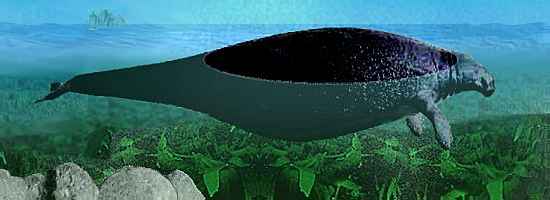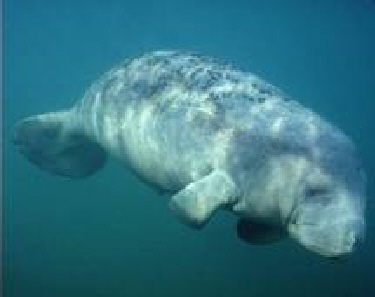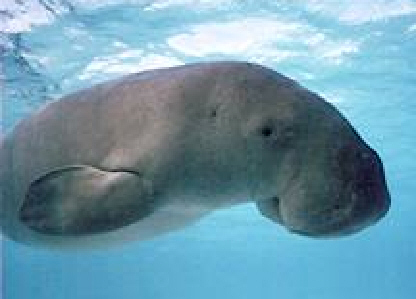HOME
ANIMALS
MAMMALS
Sirenia
Sirenia are an
order of aquatic herbivorous mammals, including the dugong, the
manatee, and the extinct Steller's sea cow. The term sea cow is also
popularly used for the dugong and the manatee; they attain a length
of 8 to 15 feet and superficially resemble the walrus. The dugong has
a bilobed tail fin; that of the manatee is broad and rounded. The
dugong inhabits the Red Sea, the Indian Ocean, and the coastal waters
north of Australia. Manatees are found in the warm waters of the
Atlantic Ocean off the American and African coasts. Both dugongs and
manatees may also be found far from the ocean in inland rivers and
lakes. Steller's sea cows are now extinct but once inhabited the
Bering Sea.
Steller's Sea Cow
 A
long-extinct, herbivorous, aquatic mammal related to the manatee and
dugong. The only record of these animals is from Georg Wilhelm
Steller, a German physician and naturalist. He discovered the
enormous sea cow in 1741 when he and a Russian exploring party were
shipwrecked on the Commander Islands in the Bering Sea. By the time
Steller discovered these sea cows, their range had become limited to
waters near these islands. In prehistoric times, the sea cow's
habitat ranged from the rim of the North Pacific near Japan to Baja
California in Mexico.
A
long-extinct, herbivorous, aquatic mammal related to the manatee and
dugong. The only record of these animals is from Georg Wilhelm
Steller, a German physician and naturalist. He discovered the
enormous sea cow in 1741 when he and a Russian exploring party were
shipwrecked on the Commander Islands in the Bering Sea. By the time
Steller discovered these sea cows, their range had become limited to
waters near these islands. In prehistoric times, the sea cow's
habitat ranged from the rim of the North Pacific near Japan to Baja
California in Mexico.
These massive,
placid creatures inhabited shallow, sandy areas along the shore.
Steller wrote that they particularly liked "the mouths of the
gullies and brooks, the rushing fresh water of which always attracts
them in herds." Showing no fear of humans, the sea cows allowed
themselves to be touched from the shore.
 Steller's
sea cows reached lengths of at least 24 feet and may have weighed up
to 10 tons. A Steller's sea cow skeleton in the Leningrad Zoological
Museum measures just over 23 feet. Their heads were small relative to
their rotund bodies, and their tiny eyes, Steller wrote, were no
larger than sheep's eyes. Their short forelimbs ended in bristled,
hooflike flippers. Their skin was dark brown, rough as tree bark, and
sometimes streaked or spotted with white. The skin was also
remarkably tough and elastic; a scientist in Hamburg, Germany,
rehydrated a piece of preserved sea cow hide and remarked on its
surprising resemblance to the thick rubber of car tires. This durable
skin protected the giant mammal as it swam near rocks and sharp-edged
ice floes.
Steller's
sea cows reached lengths of at least 24 feet and may have weighed up
to 10 tons. A Steller's sea cow skeleton in the Leningrad Zoological
Museum measures just over 23 feet. Their heads were small relative to
their rotund bodies, and their tiny eyes, Steller wrote, were no
larger than sheep's eyes. Their short forelimbs ended in bristled,
hooflike flippers. Their skin was dark brown, rough as tree bark, and
sometimes streaked or spotted with white. The skin was also
remarkably tough and elastic; a scientist in Hamburg, Germany,
rehydrated a piece of preserved sea cow hide and remarked on its
surprising resemblance to the thick rubber of car tires. This durable
skin protected the giant mammal as it swam near rocks and sharp-edged
ice floes.
Steller's sea
cows fed exclusively on kelp growing around the Commander Islands.
Lacking teeth, they ground the seaweed between two bony chewing
plates. To satisfy their large appetites, they spent most of their
time feeding with their heads down and their backs exposed above the
water surface.
Steller
guessed that most calves were born in the autumn, although he
believed that some reproduction occurred year-round. He observed that
mating took place in the spring. He also noted that these gentle
animals protected their young, always putting them in the middle when
swimming in groups. Steller further noted that when a sea cow was
harpooned, others would immediately gather around it, and some would
even try to overturn the hunter's dinghy. Sea cows would also lie on
their side next to the wounded animal and would also try to pull the
harpoon out of the body-sometimes succeeding.
At the time
that Steller discovered this species, there were an estimated 1500 to
2000 sea cows. Steller and the rest of his exploring party were
eventually rescued and returned to Russia laden with valuable otter,
seal, and Arctic fox furs. Word spread to hunters of the fortune to
be made in fur trade from the Commander Islands. From 1743 to 1763
hundreds of hunters arrived in the Bering Sea. They found this
slow-moving sea cow an easy target for meat, blubber, and hide. By
1768, 27 years after it was discovered, the Steller's sea cow had
become extinct.
Manatee
 A
common name for each of three species of a large water mammal,
popularly called a sea cow because it grazes on marine grasses and
other water plants. The Amazonian manatee ranges throughout the
Amazon River basin in South America; the West African manatee occurs
in rivers and coastal waters of tropical West Africa; and the West
Indian, or Caribbean, manatee is found in rivers and coastal waters
from the southeastern United States and the Gulf of Mexico to the
Caribbean Sea and northeastern Brazil.
A
common name for each of three species of a large water mammal,
popularly called a sea cow because it grazes on marine grasses and
other water plants. The Amazonian manatee ranges throughout the
Amazon River basin in South America; the West African manatee occurs
in rivers and coastal waters of tropical West Africa; and the West
Indian, or Caribbean, manatee is found in rivers and coastal waters
from the southeastern United States and the Gulf of Mexico to the
Caribbean Sea and northeastern Brazil.
An adult
manatee has a rounded body, usually colored light to dark gray or
black, that tapers to a horizontally flattened, rounded tail. It is 8
to 14 feet long, depending on the species, and weighs 440 to 1300
pounds. The small head includes a straight snout and a cleft upper
lip with bristly hairs. Its nostrils, set on the upper surface of the
snout, are closed tightly by valves when the animal is under water.
The paddlelike forelimbs are set close to the head; no external hind
limbs exist. Massive, heavy bones and long, narrow lungs, which
extend through the entire body cavity, give the manatee evenly
distributed buoyancy. A manatee cow gives birth about a year after
mating; usually a single, pink calf is born.
Manatees live
in small family groups, although they occasionally travel in herds of
15 to 20. They feed in both freshwater and salt water, grazing for
six to eight hours a day. An adult consumes an amount equal to
between 5 and 10 percent of its body weight daily. Manatees have a
slower metabolism than other mammals of similar size, which sharply
reduces their energy requirements. This is especially important for
Amazonian manatees when waters recede after floods, confining some
for extended periods in shallow waters away from plants on river banks.
Manatees have
few natural enemies because of their size. However, their population
has been reduced significantly by heavy hunting for hides, meat, and
blubber oil, and they are frequently injured or killed in collisions
with boats. Efforts to protect manatees in Africa and South America
sometimes conflict with the traditional subsistence hunting of these
animals. A practical consideration that supports conservation efforts
is the fact that manatees help clear plant-clogged river channels
used for irrigation and transportation. The World Conservation Union
lists each species of manatee as vulnerable (a term that indicates
the animal is facing a high risk of extinction in the wild in ten or
more years).
Dugong
A large marine
mammal that inhabits the tropical waters of the Indian and western
Pacific oceans.  It
is commonly called a sea cow. The dugong's massive body is about 8
to 9 feet long and tapers to a forked, horizontally flattened tail.
The forelimbs are rounded flippers; no hindlimbs remain. Large,
muscular lips (the upper one cleft) are used for tearing off water
plants. Molars and hard pads at the front of the jaws grind the food;
the male also has two small, tusklike incisors. Feeding mainly at
night, the dugong commonly travels in pairs or in small groups. After
a gestation of about 13 to 14 months, the young, usually a single
offspring, is born in the water and suckles at the mother's pectoral teats.
It
is commonly called a sea cow. The dugong's massive body is about 8
to 9 feet long and tapers to a forked, horizontally flattened tail.
The forelimbs are rounded flippers; no hindlimbs remain. Large,
muscular lips (the upper one cleft) are used for tearing off water
plants. Molars and hard pads at the front of the jaws grind the food;
the male also has two small, tusklike incisors. Feeding mainly at
night, the dugong commonly travels in pairs or in small groups. After
a gestation of about 13 to 14 months, the young, usually a single
offspring, is born in the water and suckles at the mother's pectoral teats.
This harmless
sea animal has long been hunted for its meat, blubber, oil, and hide,
and today the world population of dugongs is believed to be reduced
to less than 40,000. They are now classified as endangered. Dugongs
were sometimes viewed by early voyagers as mermaids and were
identified with the Sirens of mythology.
Scientific classification
Manatees make
up the family Trichechidae in the order Sirenia. The Amazonian
manatee is classified as Trichechus inunguis, the West African
manatee as Trichechus senegalensis, and West Indian manatee as
Trichechus manatus. The dugong makes up the family Pugongidae in the
order Sirenia. It is classified as Dugong dugon. The Steller's sea
cow belonged to the family Trichechidae of the order Sirenia.
 A
long-extinct, herbivorous, aquatic mammal related to the manatee and
dugong. The only record of these animals is from Georg Wilhelm
Steller, a German physician and naturalist. He discovered the
enormous sea cow in 1741 when he and a Russian exploring party were
shipwrecked on the Commander Islands in the Bering Sea. By the time
Steller discovered these sea cows, their range had become limited to
waters near these islands. In prehistoric times, the sea cow's
habitat ranged from the rim of the North Pacific near Japan to Baja
California in Mexico.
A
long-extinct, herbivorous, aquatic mammal related to the manatee and
dugong. The only record of these animals is from Georg Wilhelm
Steller, a German physician and naturalist. He discovered the
enormous sea cow in 1741 when he and a Russian exploring party were
shipwrecked on the Commander Islands in the Bering Sea. By the time
Steller discovered these sea cows, their range had become limited to
waters near these islands. In prehistoric times, the sea cow's
habitat ranged from the rim of the North Pacific near Japan to Baja
California in Mexico. Steller's
sea cows reached lengths of at least 24 feet and may have weighed up
to 10 tons. A Steller's sea cow skeleton in the Leningrad Zoological
Museum measures just over 23 feet. Their heads were small relative to
their rotund bodies, and their tiny eyes, Steller wrote, were no
larger than sheep's eyes. Their short forelimbs ended in bristled,
hooflike flippers. Their skin was dark brown, rough as tree bark, and
sometimes streaked or spotted with white. The skin was also
remarkably tough and elastic; a scientist in Hamburg, Germany,
rehydrated a piece of preserved sea cow hide and remarked on its
surprising resemblance to the thick rubber of car tires. This durable
skin protected the giant mammal as it swam near rocks and sharp-edged
ice floes.
Steller's
sea cows reached lengths of at least 24 feet and may have weighed up
to 10 tons. A Steller's sea cow skeleton in the Leningrad Zoological
Museum measures just over 23 feet. Their heads were small relative to
their rotund bodies, and their tiny eyes, Steller wrote, were no
larger than sheep's eyes. Their short forelimbs ended in bristled,
hooflike flippers. Their skin was dark brown, rough as tree bark, and
sometimes streaked or spotted with white. The skin was also
remarkably tough and elastic; a scientist in Hamburg, Germany,
rehydrated a piece of preserved sea cow hide and remarked on its
surprising resemblance to the thick rubber of car tires. This durable
skin protected the giant mammal as it swam near rocks and sharp-edged
ice floes. A
common name for each of three species of a large water mammal,
popularly called a sea cow because it grazes on marine grasses and
other water plants. The Amazonian manatee ranges throughout the
Amazon River basin in South America; the West African manatee occurs
in rivers and coastal waters of tropical West Africa; and the West
Indian, or Caribbean, manatee is found in rivers and coastal waters
from the southeastern United States and the Gulf of Mexico to the
Caribbean Sea and northeastern Brazil.
A
common name for each of three species of a large water mammal,
popularly called a sea cow because it grazes on marine grasses and
other water plants. The Amazonian manatee ranges throughout the
Amazon River basin in South America; the West African manatee occurs
in rivers and coastal waters of tropical West Africa; and the West
Indian, or Caribbean, manatee is found in rivers and coastal waters
from the southeastern United States and the Gulf of Mexico to the
Caribbean Sea and northeastern Brazil. It
is commonly called a sea cow. The dugong's massive body is about 8
to 9 feet long and tapers to a forked, horizontally flattened tail.
The forelimbs are rounded flippers; no hindlimbs remain. Large,
muscular lips (the upper one cleft) are used for tearing off water
plants. Molars and hard pads at the front of the jaws grind the food;
the male also has two small, tusklike incisors. Feeding mainly at
night, the dugong commonly travels in pairs or in small groups. After
a gestation of about 13 to 14 months, the young, usually a single
offspring, is born in the water and suckles at the mother's pectoral teats.
It
is commonly called a sea cow. The dugong's massive body is about 8
to 9 feet long and tapers to a forked, horizontally flattened tail.
The forelimbs are rounded flippers; no hindlimbs remain. Large,
muscular lips (the upper one cleft) are used for tearing off water
plants. Molars and hard pads at the front of the jaws grind the food;
the male also has two small, tusklike incisors. Feeding mainly at
night, the dugong commonly travels in pairs or in small groups. After
a gestation of about 13 to 14 months, the young, usually a single
offspring, is born in the water and suckles at the mother's pectoral teats.